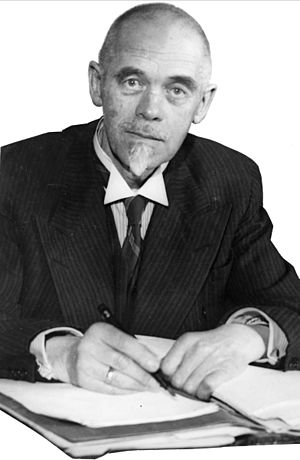Peter Egge facts for kids
Quick facts for kids
Peter Egge
|
|
|---|---|

Peter Egge in 1935
|
|
| Born | 1 April 1869 Trondheim, Norway |
| Died | 15 July 1959 (aged 90) Oslo, Norway |
| Nationality | Norwegian |
| Period | 1891–1955 |
| Genre | Novel Comedy Romance |
| Spouse | Anne-Marie Svensen (1897–1959; his death) |
| Children | Ørnulf Egge Asta Egge Randi Egge |
Peter Egge (born April 1, 1869 – died July 15, 1959) was a famous Norwegian writer. He wrote many books, plays, and worked as a journalist. His writing career lasted a long time, from 1891 to 1955.
Contents
Peter Egge's Life
Growing Up in Norway
Peter Egge was born in Trondheim, Norway. He was the second oldest of nine children. His family came from a place called Nord-Trøndelag.
During summer holidays, Peter often visited relatives in the countryside. These trips helped him later in his writing. He often wrote about Trondheim and the old traditions of the Innherred area.
His Writing Career
Peter Egge went to the Trondheim Cathedral School and finished in 1887. He started his writing career with a novel called Almue in 1891.
Later, he became a journalist for a newspaper in Trondheim called Dagsposten. For many years, he worked as both a journalist and a writer. He was very good at writing comedies, which are funny plays. Some of his successful comedies include Faddergaven (The Christening Gift, 1897).
Egge also wrote serious plays. One example is Kjærlighed og Venskab (Love and Friendships, 1904). He continued to write both funny and serious stories throughout his career. Other important works from this time were Jomfru Nelly Maartens (Miss Nelly Maartens, 1897) and Hjertet (The Heart, 1907).
In the early 1920s, Peter Egge's writing style began to change. He started writing less about romance and more about real life. This new style is sometimes called "neo-realistic." His stories became very detailed. This change led to his most famous book, Hansine Solstad, published in 1925.
Peter Egge also helped lead groups for writers. He was the chairman of the Norwegian Authors' Union from 1913 to 1916 and again in 1935. He also led the literary advice committee in 1920 and 1929.
Family Life
In 1897, Peter Egge married Anna Marie Svensen. They moved to Christiania, which is now called Oslo. Peter Egge was the father of Ørnulf Egge, who became a politician and a member of the Norwegian resistance during World War II.
Awards and Recognition
Peter Egge received the Gyldendal's Endowment award in 1935 for his writing.
See also
 In Spanish: Peter Egge para niños
In Spanish: Peter Egge para niños

